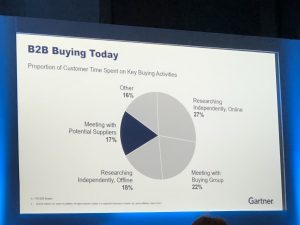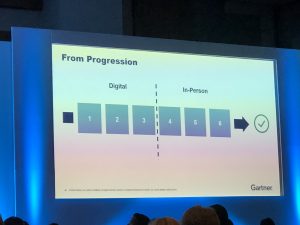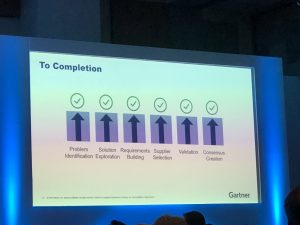Last week I attended Gartner’s Sales & Marketing Conference where I joined leaders in sales, marketing, and sales enablement to discuss latest trends, Gartner research, and the future of these functions. There was a lot to take in, but this post will do its best to summarize overarching themes and key takeaways to think about as you discuss and strategize 2019 initiatives.

In the first session of the conference Scott Collins, VP of Advisory at Gartner, shared a recent study of 750 B2B buyers. The study found that 27% of the overall buying journey is spent researching independently, online. 22% is spent meeting with an internal buying group (they’re 49% of the way through, and still haven’t spoken with sales). 18% is spent researching independently, offline. 16% is spent doing “other.” Finally, just 17% of the overall buying journey is spent meeting with potential suppliers. But remember, you’re not the only supplier. “There are fewer opportunities for sales to communicate potential value,” Collins said. Your sales team is lucky to interact with a buyer for 5% of their overall journey. The slice of that 17% that you do get, needs to be customer-focused and value-driven.
Brent Adamson, Distinguished VP of Advisory at Gartner, later added in his Keynote, “How do we win the right to get more time with our customers? Well, we’ve got to provide more value. We have to give our customers a reason to talk to us in the first place.”
WHAT ARE YOU GOING TO SAY THAT CUSTOMERS HAVEN’T FIGURED OUT ON THEIR OWN?
This is a huge concern of sales leaders wondering if their reps are equipped to deliver this kind of value, especially when the typical sales presentation covers company history, features and benefits. Their answer to the concern? … More reps! If they don’t work, bring in the subject matter experts! If they don’t work, bring in the sales engineers! If they don’t work, bring in the sales leaders! If they don’t work, bring in the freaking C-suite!! … As you may have already imagined, this is not a scalable plan.

So how do we advance customers through their purchase? The first step is understanding the purchase. Historically, we’ve thought about B2B buying as a linear progression: moving from digital marketing to in-person sales meetings. Gartner put a whole new spin on the journey as we know it stating, “B2B buying isn’t linear – it’s about completion, not progression.” Specifically, the completion of 6 jobs and their correlated sub-tasks:
- Problem Identification: Buyers must identify and learn about a business problem, size/scope the business problem, and consider budget.
- Solution Exploration: Buyers must explore the different solutions that solve the problem, learn what peers use, and narrow the field of potential suppliers and solutions.
- Requirements Buildings: Buyers must set requirements for the solution, build RFP and tools to evaluate and compare options, request and receive demos for the solution, and possibly revisit the desired purchase goal.
- Supplier Selection: Buyers must compare RFP responses and demos, engage suppliers with final-mile questions, consider trade-offs, evaluate implementation challenges, solicit end-user feedback and references, and eliminate suppliers.
- Validation: Buyers must confirm independent learning, consult peer/professional acquaintances, corroborate suppliers’ claims, review third-party expert analysis, and solicit end-user feedback and customer references.
- Consensus Creation: Buyers must build a shared understanding of the problem within the buying group, educate stakeholders outside of the immediate buying group, surface and resolve disagreements/engage in debate, build a business case, and secure budget.
 Customers are looking for helpful information from marketing and sales to complete these jobs. Gartner labeled the provision of information that supports the completion of critical buying jobs as “Buyer Enablement”. We must deploy Buyer Enablement through both in-person and digital channels to support job completion.
Customers are looking for helpful information from marketing and sales to complete these jobs. Gartner labeled the provision of information that supports the completion of critical buying jobs as “Buyer Enablement”. We must deploy Buyer Enablement through both in-person and digital channels to support job completion.
Brent Adamson states, “If we only had one battle to fight it wouldn’t be in sales, marketing, nor marketing and sales alignment. It would be in buying.” There is value to you as a supplier providing the right help to buyers. Potentially huge value. But how do we drive more value to win more quality deals? How do we progress buyers through the pipeline? Well, we have to achieve just one goal:
MAKE BUYING EASIER.
Buyer Enablement is all about anticipating buying obstacles and providing the help in both in-person and digital channels to overcome those hurdles. For any given buying job, there are a number of specific, tactical ways that suppliers can support job completion. Here is Gartner’s Supplier Intent “Checklist” (what we, as suppliers, need to do to support each buying job):
- Problem Identification: Suppliers must compare customer’s performance against peers, quantify cost/benefits of action/inaction, and prompt exploration of overlooked questions/information.
- Solution Exploration: Suppliers must evaluate alternatives, visualize the solution in customer context, and prioritize possible trade-offs.
- Requirements Building: Suppliers must identify solution criteria, prompt exploration of overlooked questions/information, and prioritize possible trade-offs.
- Supplier Selection: Suppliers must compare competing supplier solutions, visualize the solution in customer context, evaluate alternatives, and prioritize possible trade-offs.
- Validation: Suppliers must provide unique support for customer conclusions and affirm readiness to move forward.
- Consensus Creation: Suppliers must anticipate internal debates and stakeholders’ objections, establish a framework for discussions/decisions, and define minimum thresholds for agreement.
In order to construct a Buyer Enablement ecosystem, we have to use tools that address the various aspects of supplier intent, and streamline them between marketing and sales. The design principles of Buyer Enablement tools (at a minimum) are relevant, easy, useful, and credible. Recommended principles include shareable, aligned to customer’s emotional needs, provides confidence, and leads to supplier’s unique strengths.
Key Takeaways:
- Buying difficulty has commercial consequences.
- Customers are looking for information, not conversations. They want the conversation for the sake of information.
- B2B buying isn’t linear – it’s about completion, not progression.
- Customers are channel agnostic when it comes to job completion.
- Suppliers must deploy Buyer Enablement through both sales and marketing channels for all buying jobs.
Anti-Key Takeaway:
Brent Adamson made sure to right a wrong in his closing keynote. The same quote was posted throughout the conference on social media: “Brent says, ‘Your customers want a seamless experience!’” Firstly, Brent wants us to know Brent did not say that! Secondly, customers don’t want an experience; customers want help. Lastly, it’s not that customers want a seamless experience, it’s that customer do go to multiple channels to find the help they need. They are seeking information, and it’s in our best interest as a supplier to make that process easier.
In addition to the main theme of Buyer Enablement, there were countless other helpful tidbits of information, research, case studies, and conversations. To leave you with, here are 10 of my favorite quotes and statistics heard over my three days in Las Vegas (in no particular order):
- “There are fewer opportunities for sales to communicate potential value.” (Scott Collins, VP of Advisory at Gartner)
- “How do we win the right to get more time with our customers? We’ve got to provide more value. We have to give our customers a reason to talk to us in the first place.” (Brent Adamson, Distinguished VP of Advisory at Gartner)
- “What are you going to say that customers haven’t figured out on their own?” (Brent Adamson)
- “How can we start showing up as learn-it-alls instead of know-it-alls?” (Rick Sirois, Director of Business & Operations Program Management at Microsoft)
- “When data and stories are used together, audiences are affected both intellectually and emotionally.” (Jennifer Aaker, Behavioral Psychologist, Author and Professor at Stanford Graduate School of Business)
- “How many of you use PowerPoint?” **Almost the whole audience raises their hand.** “Okay, that’s a problem!” (Jennifer Aaker)
- “People always ask, ‘Well, how do I know what’s hard for my buyer?’ …Ask them!” (Brent Adamson)
- “What factors slowed down your B2B purchase?” 28.81% answered “difficulty showing ROI.” (Showpad Study)
- “Which tools, if they were available, would accelerate buying decisions?” 44.05% answered “ROI analysis or calculator.” (Showpad Study)
- The #1 reason sales don’t make quota: Inability to articulate unique value. (SiriusDecisions Study)

